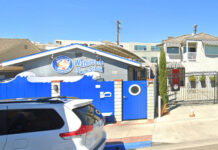By Mike Schaadt
Seal Beach National Wildlife Refuge
Part of a continuing series about the local wildlife refuge.
Fiddler crabs live in protected bays and estuaries in many parts of the world. They are small crabs, with their carapace (shell) rarely reaching an inch for males and less than that for the smaller females. The local species of fiddler crabs (Uca crenulata crenulata) occur only in Southern California so they can be seen at Bolsa Chica wetland, Anaheim Bay and the estuary of the Seal Beach National Wildlife Refuge (SBNWR).
Their common name comes from the movement of the small claw which during feeding moves from the mud to the mouth and back. Along with the proximity of the large claw of the male the movement is reminiscent of someone playing a fiddle. Female crabs have claws of equal small size. Males use their large claw in fights with other males and to entice a female into its burrow for mating. At low tide the males can be seen waving their large claws in what looks some kind of coordinated ballet. Japanese call fiddler crabs siho maneki which translates to “beckoning for the return of the tide.”
They feed by using their small claws to select tiny plants and animals from the mud. The rejected mud is formed into tiny balls and left around the opening to their burrowed homes. They make their burrows at the high tide line by digging holes obliquely about three feet long. The burrows terminate in a horizontal chamber. To keep out seawater at high tide, the crabs block up the entrance to the burrow with the tiny balls of mud they make with their legs. They also line their burrow walls with mud helping to make the burrow more impervious to saltwater. Fiddler crabs can live in water of various amounts of saltiness which serves them well at high tide and during heavy rains.
Back in the days when coastal Los Angeles/Orange County areas were primarily estuaries leading to sandy beaches, there was plenty of estuarine habitat for fiddler crabs. Today, with only about 10% of estuaries remaining due to urbanization, fiddler crabs have become rare. The SBNWR is one of the few more natural estuaries remaining where fiddler crabs are abundant. It is truly a rare treat to watch the fiddlers do their dance at low tide. If you join an end of the month Saturday tour at the Refuge, and the tide is right, you just might be treated to seeing fiddler crabs doing their claw ballet!
Mike Schaadt is a volunteer with the Friends of Seal Beach National Wildlife Refuge.












